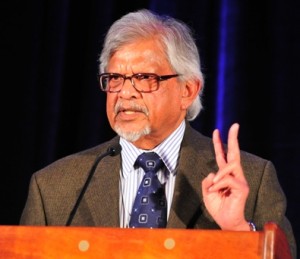Grandfather Gandhi by Arun Gandhi with Bethany Hegedus, illustrated by Evan Turk (Atheneum Books for Young Readers, 2014) is Arun’s story about living on the Sevagram with his grandfather, the Mahatma Gandhi.
The Sevagram in India is dirty and dusty. Young Arun doesn’t like eating mushy, boiled pumpkin. He doesn’t speak Gujarati well, and he certainly doesn’t like sharing Grandfather with over three hundred and fifty followers. But he knows Grandfather is important because of his peaceful teachings.
For Arun, peace feels unattainable. He worries he’ll never make his grandfather proud. When an incident on the soccer field leaves Arun ready to strike, he runs away, ashamed, straight to his grandfather’s hut. There he discovers that everyone feels anger. Even his grandfather. Grandfather helps Arun understand how anger can be “like lightning, and split a living tree in two” or “a switch can be flipped, and it can shed light like a lamp.” Grandfather doesn’t force Arun to choose. But Arun does. He’ll be a lamp.
An enlightening story that is sure to bring about change and inspire the pledge “to live life as light.” The collaboration between authors and illustrator is nothing short of brilliant. Words and pictures work together seamlessly, a true testament to the picture book art form. For ages 3+

Knowing there were many more layers to her debut picture book, we asked Bethany Hegedus to stop by and chat more personally with us. Here’s what she had to say:
ReaderKidZ: What inspired you to write Grandfather Gandhi? Why do you think this story is important for young readers?
Bethany: Grandfather Gandhi became a personal mission of mine after hearing Arun Gandhi speak in the months after 9/11. I was a fire searcher for the company I worked for at that time and I was at the WTC that day. Arun’s talk helped me begin to heal. I wanted to put something good into the world. Seeing this story through became, for me, the reason I was at the WTC that day. It was a route to healing, not just for me, but for others as well.
The story is important for all readers I think, but especially for young readers. It’s an eye-opening moment – not just for Arun, but for readers, as well – when we learn in the book that Mahatma Gandhi, a world-leader known for his non-violent protests, felt anger. We all think anger leads to violence, to acting out, to losing control. But it doesn’t have to. Many kids today don’t know the work of Gandhi, let alone that anger can be used for good. If we listen to what makes us angry, to what hurts our feelings, and we make a choice to act – rather than react – anger can help us heal the world. Young kids want to make the world a better place. I hope this book gives them the tools and confidence to know they can.
 ReaderKidZ: The story was co-written with Mahatma Gandhi’s grandson Arun. Tell us about your writing relationship. What was the path to publication?
ReaderKidZ: The story was co-written with Mahatma Gandhi’s grandson Arun. Tell us about your writing relationship. What was the path to publication?
Bethany: Arun is the 5th grandson of the Mahatma. He is a world leader himself, traveling and speaking and sharing lessons and tools on how to lead a non-violent life. Arun and I began working on this book together when he was 68 and I was 29. It is now being released into the world, near Arun’s 80th birthday. We shaped the book through email interviews, phone conversations, and one in-person meeting at his home in Rochester, New York. Later in March, I will see him again when we speak together and share the book at Books of Wonder in NYC and other areas.
The path to publication for this book was rocky. We wrote and revised for 8 years before it was offered a contract in 2010. But now that this beautifully illustrated book is published, I don’t believe Arun or I would change a moment of the journey. On Facebook, Arun said, “Finally coming to fruition after 12 years of hard work. The fruits are sweet.” And, indeed they are.
ReaderKidZ: This story went through many revisions, how did you uncover the heart? And why did you never give up on the book?
Bethany: We always knew we were doing something special by offering readers a personal glimpse into the life of Mahatma Gandhi, helping readers see Gandhi as a grandfather. But it wasn’t until the story became fully Arun’s, a book about his shame over feeling anger and his desire to want to strike back, that the heart of the story was uncovered. As with all emotional truths, it takes time to peel back the layers and discover what is really at the center. Once we tapped into that shame, Arun’s journey from despair to healing was evident. We hope this journey can be felt by readers of all ages and our readers’ own journeys of shame-to-healing can be charted.
Giving up on the book was never an option. It would have meant giving up on myself and giving up on Arun and giving up on the work that Gandhi’s life illuminated. That thought never entered the picture. I am very grateful Arun Gandhi never gave up on me as the source to help him share this time with his grandfather and the lessons he learned while living at Sevagram.
ReaderKidZ: Evan’s illustrations are works of art. How did you respond when you first saw his vision dancing across the page? And what do you think his collaboration brought to this project?
Bethany: I can’t say it enough, our illustrator Evan Turk is a genius. This is Evan’s picture book debut. He did so much to bring the emotional truths in the book to life using his tactile and versatile art style of watercolor, paper collage, gouache, pencil, tea, tin foil and hand spun cotton. He captures the darkness and confusion of anger and the illumination of love and light in a way I never would have dreamed possible.
As I read through the book, on every spread I announce, “This one is my favorite.” When I shared the F&G’s with my family, my then 8 year-old nephew noticed Arun’s shadow in the prayer meeting sequence is jagged and all the others firmly cut. It is this attention to detail and the way his art conveys the emotional truths of a child, and in particular young Arun’s life, that make Evan an illustrator to watch.
To learn more about this beautiful book and its journey visit www.grandfathergandhi.com.










